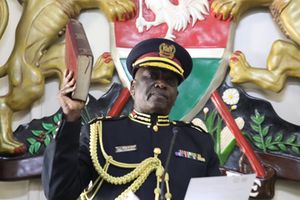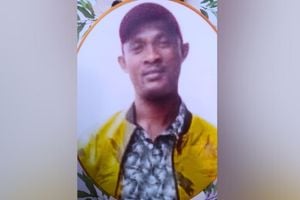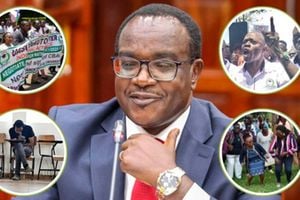Premium
How the 1969 Kisumu massacre transformed and united Luo Nyanza

Police disperse crowds in Kisumu by shooting indiscriminately during a visit by Jomo Kenyatta on October 25, 1969. PHOTO | FILE | NATION MEDIA GROUP
What you need to know:
- Between 1964 and 1969, there was an ideological split among the nationalists within Kanu and related developments.
- On January 29, 1969, the death of a prominent regional politician, CMG Argwings Kodhek, sparked massive outrage and violence in Nairobi and Nyanza, adding to the tensions already built up by the persecution of Jaramogi and his colleagues
Mzee Odungi Randa, the recently appointed chairman of the Luo Council of Elders, vividly remembers Black Saturday, October 25, 1969. To him, it seems like yesterday.
He was 28 years old and an aide to Jaramogi Oginga Odinga, Kenya's first vice president.

Ker Odungi Randa after he was crowned as the leader of the Luo Council of Elders during Piny Luo extravaganza at Homa Bay High School on July 1,2023.
That morning, Mr Randa was at the Odinga home in Milimani, Kisumu, where his children Raila Odinga and the last born Ruth Odinga were present. They were preparing to welcome founding President Jomo Kenyatta to officially open the Nyanza Provincial Hospital (now renamed Jaramogi Oginga Odinga Teaching and Referral Hospital, but always commonly known as 'Russia' because it was built with Soviet aid).
"We left for the venue of the event, but when we reached the gate, we could feel some tension following the preceding events that had irked the region since they had lost leaders dear to them," said Mr Randa.
They were sitting inside the venue waiting for the President when the chants of Dume Dume, associated with Jaramogi's Kenya People's Union (KPU) party, filled the air. Those chanting wore green shirts with round collars, while others expressed anger and demanded justice for the controversial deaths of prominent community leaders.
Between 1964 and 1969, there was an ideological split among the nationalists within Kanu and related developments.
Jaramogi, a prominent son of the region, was expelled from the government in 1965, and although he formed the opposition party KPU that year, the state frustrated him and his compatriots in the party during the 'Little General Elections of 1966', restricting his party's influence to Nyanza.
On January 29, 1969, a prominent regional politician, CMG Argwings Kodhek, died in a suspicious car accident in Nairobi.
Six months later, on July 5, 1969, the then Minister of Economic Planning, Tom Mboya, also from the region, was assassinated in the streets of Nairobi.
The two deaths sparked massive outrage and violence in Nairobi and Nyanza, adding to the tensions already built up by the persecution of Jaramogi and his colleagues in the then ruling party, Kanu, and the state brutality against him and his KPU supporters since 1966.
Things quickly went south when President Jomo Kenyatta threatened to crush Jaramogi over the hostile reception he received in Nyanza.
According to Mr Randa, the event, which was supposed to be the official opening of the hospital, turned violent with state security officers opening fire on unarmed civilians as President Kenyatta was being evacuated from Kisumu along the Kisumu-Ahero-Kericho road.
“A confrontation ensued and before we knew it, we were rushing to hide on the second floor of the hospital with Jaramogi and his daughter Ruth. Raila disappeared during the melee and we started looking for him after things cooled down and the presidential motorcade had left,” said Mr Randa.
According to the Luo Ker, many people were shot dead, including the son of then Nation Media Group distributor Abdul Hussein Dahya, Alnoor, who was a standard four pupil at Aga Khan Primary School and whose life was snuffed out near Kibuye market.
Mr Randa recalls how the presidential guard went on a shooting spree from Kisumu town to Nyamasaria, Ahero and Awasi before taking a break in Kericho.
More than 50 people were killed, including children. There are allegations that the official figures for this incident were deliberately under-reported.
“When they stopped in Kericho, the president called for an impromptu meeting to impose a curfew, placed Jaramogi under house arrest, and detained other KPU leaders,” said Mr Randa.
According to him, this bloody incident has completely changed the politics of the region and the country to date. He explained that the Nyanza region decided to unite even more as they felt marginalised and targeted by the government.
“All this was staged to facilitate the arrest of Jaramogi and kill KPU. Jaramogi had become popular and had elections been called, he would have won by a landslide. That is why this had to be done,” said Mr Randa.

KPU leader Jaramogi Oginga Odinga (with cap) in an exchange with President Jomo Kenyatta in October 25, 1969, shortly before Mzee's bodyguards opened fire and killed about 50 people in Kisumu.
Mzee Adhiambo Lomo credits his sixth sense for deciding not to go to the hospital that day.
He was 30 years old when the now famous 'Kisumu massacre' took place, and he too joined Jaramogi's motorcade to the hospital shortly after having lunch with the country's first vice president at the Winam Hotel.
The 84-year-old was then a co-operative officer in charge of the Muhoroni Settlement Scheme, but was also very active in politics, having chosen to be a Jaramogi youth wing at a tender age.
That day he left his car at the district commissioner's office, went to lunch and later joined Jaramogi's motorcade to the hospital.
“But on the way, I felt that something was not right and did not want to go…I alighted [from the car] just outside Russia,” said Mr Lomo.
He walked all the way to Jubilee Market, adjacent to Kisumu's main bus park, to listen to the radio.
That is when he heard that there had been an altercation between Jaramogi and President Kenyatta, and before he knew it, security guards were speeding along the Nairobi-Kisumu road, shooting indiscriminately.
“I was being carried by a friend on a bicycle when one of the officers threw a food can at us and beat other people on their way to Nyamasaria,” said Mr Lomo.
It is because of the horrific killings and beatings witnessed that day that Luos coined the phrase 'Goch Kisumo', loosely translated as 'Kisumu style beatings'.
And like Mr Randa, Mr Lomo strongly believes that the heckling and violence was well planned by President Kenyatta's agents, whose actions aroused suspicion by the way they altered the President's schedule, including changing the routes.
He also believes that those wearing KPU shirts were planted with clear instructions to disrupt the event, adding that this explains why they were nowhere to be seen and were not injured or killed when they would have been the easier targets.
Mzee Onyango Radier, another former Jaramogi aide and one-time deputy mayor of Kisumu, echoes the same sentiments, saying that the government had tried many schemes to dilute the growing influence of the KPU and this incident was a good opportunity to stamp out the party's and Jaramogi's influence.
He pointed out that the unity witnessed among the Luo was a result of this single incident, which turned them against successive governments that had marginalised them.
The region was subsequently marginalised and alienated from national development, with little consensual and meaningful political representation at the national level.
“If you see the unity of the Luo people are having behind their leaders, it is because they came to realise that we were all declared the enemy by the government and could not explain why they shot innocent people by the roadside. It is the hostility of the regime that we put into power and had turned against us that united us more,” said Mr Radier.
However, he believes that appointing a few people to the government will not lead to the development of the community.
“God has helped us with people who are capable of leading. It is just that we deserve it but we have been denied several times but the unity of the Luo community will one day pay off and will be sweeter than ever,” said Mr Radier.
Siaya Governor James Orengo, a close ally of Jaramogi during his time at Ford Kenya, was a Form Three student at Alliance High School when the massacre took place.

Siaya Senator James Orengo.
He recalls how President Kenyatta, then Vice-President Jaramogi and Tom Mboya were very close to each other and used to visit them at school.
Mr Orengo told the Nation that the close relationship between the president and the vice president was so cordial that they used to wear matching beaded hats and looked inseparable.
“It was a surprise when they started to disagree. The October 25th incident became the turning point which not only turned into violence and police brutality, but also led to successive transactional political alliances as opposed to shared ideology,” he said.
Mr Orengo added that even post-election demonstrations are a replica of the Kisumu massacre because they show a government that is opposed to the needs of the people and how they express their concerns, and the people then resort to violence and killings.
For the veteran politician, who has served in the National Assembly and the Senate, the Kisumu massacre only led to what is now "politics of deceit and selfishness", not based on ideological principles.
He pointed out that going forward, politicians who form coalitions, alliances and movements to gain power should also stick to the ideologies that drove that unity.
“Since the Kisumu incident, it looked like ideological partnership has turned to be more transactional and to attain power and nothing else, which should not be the case,” said Mr Orengo.
It is because of this and many other incidents that the Nyanza Dialogue Initiative has organised a commemoration of the Kisumu massacre to be held at the Grace Onyango Social Centre in Kisumu between 8.30am and 8.30pm on Friday, October 27.
According to veteran journalist William Oloo Janak, who is spearheading the process, the project is a culmination of activities that began last year under the name 'Crisis Communication', which consisted of a series of dialogue forums held across the region.
These aimed to build community resilience to rights violations, debunk false narratives, disinformation and misinformation, and generally build the confidence and resilience of communities to not only recognise and defend their rights, but also to tell their own stories – of struggle and desire for social justice and progressive change.





